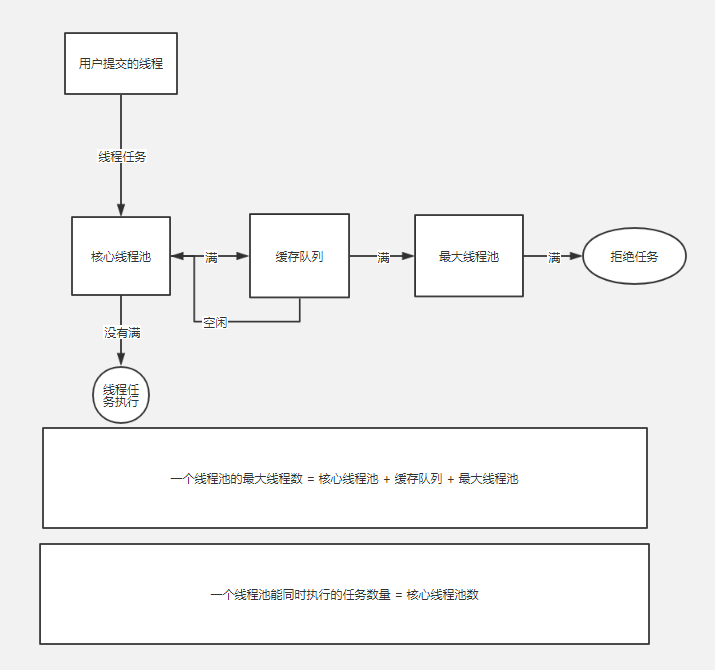手动创建线程
平时开发中经常会碰到需要用异步方式来实现某个需求,这时首先会想到这种写法
new Thread(new Runnable() {
@Override
public void run() {
System.out.println("to do something");
}
}).start();
或者用lambda简写
new Thread(()-> System.out.println("to do something")).start();
虽然这种写法可以实现需求,但是我们最好不要这样写,因为这种是不可控的。复杂的系统里,如果有很多这种写法,就会导致明明可以几个线程就能完成的任务,最后创建了几十个线程,导致线程过度切换,降低系统性能。
因此当我们需要异步处理的时候,应该使用线程池。
线程池
第一种 使用Executors创建
Executors提供了四种创建线程池的方法
- newSingleThreadExecutor 创建只有一个线程的线程池,这个线程池可以在线程死后(或发生异常时)重新启动一个线程来替代原来的线程继续执行下去!
public static void main(String[] args) {
ExecutorService executorService = Executors.newSingleThreadExecutor();
executorService.execute(new Worker());
executorService.execute(new Worker());
executorService.shutdown();
}
static class Worker implements Runnable{
@Override
public void run() {
System.out.println(Thread.currentThread().getName()+":working");
}
}
结果
pool-1-thread-1:working
pool-1-thread-1:working
- newCachedThreadPool 创建一个可缓存线程池
- newFixedThreadPool 创建一个定长线程池
- newScheduledThreadPool 创建一个线程池,它可安排在给定延迟后运行命令或者定期地执行。
不推荐使用Executors创建线程池
其实通过Executors创建的四种线程池方法,底层都是通过创建ThreadPoolExecutor来实现的,这四种方法只是为我们封装了创建的细节。但是我们平时开发中最好要知道,核心线程数多少,缓存队列大小等等这些重要的参数,这样以后出现bug不至于无从下手。
第二种 使用ThreadPoolExecutor创建
public ThreadPoolExecutor(int corePoolSize,
int maximumPoolSize,
long keepAliveTime,
TimeUnit unit,
BlockingQueue<Runnable> workQueue,
ThreadFactory threadFactory,
RejectedExecutionHandler handler) {
if (corePoolSize < 0 ||
maximumPoolSize <= 0 ||
maximumPoolSize < corePoolSize ||
keepAliveTime < 0)
throw new IllegalArgumentException();
if (workQueue == null || threadFactory == null || handler == null)
throw new NullPointerException();
this.corePoolSize = corePoolSize;
this.maximumPoolSize = maximumPoolSize;
this.workQueue = workQueue;
this.keepAliveTime = unit.toNanos(keepAliveTime);
this.threadFactory = threadFactory;
this.handler = handler;
}
- corePoolSize 核心线程数
- maximumPoolSize 最大线程数
- keepAliveTime 当线程数大于核心线程数时,空余线程等待新任务的最长时间
- unit 时间单位
- workQueue 等待队列
- threadFactory 线程工厂
- handler 当线程大于最大线程数时采用的拒绝策略
各个参数如下图所示

我们在创建的时候也可以采用ThreadPoolExecutor缺省的构造方法,其中一些参数使用默认即可。
public static void main(String[] args) {
ThreadFactory threadFactory = new ThreadNameFactory();
ThreadPoolExecutor threadPoolExecutor = new ThreadPoolExecutor(5, 10, 5, TimeUnit.SECONDS, new ArrayBlockingQueue<>(10),threadFactory);
threadPoolExecutor.execute(new Worker());
threadPoolExecutor.execute(new Worker());
threadPoolExecutor.shutdown();
}
static class ThreadNameFactory implements ThreadFactory {
private final AtomicInteger threadNumber = new AtomicInteger(1);
@Override
public Thread newThread(Runnable r) {
return new Thread(r, threadNumber.getAndIncrement()+"号员工");
}
}
static class Worker implements Runnable{
@Override
public void run() {
System.out.println(Thread.currentThread().getName()+":working");
}
}
结果
1号员工:working
2号员工:working
上面例子中我们设置了核心线程数是5,最大线程数是10,等待时间是5s,等待队列采用的是ArrayBlockingQueue,线程工厂使用自定义的,只是自定义了线程名称。
总结
平时开发中,不论什么时候都最好不要手动创建线程执行异步任务,应该使用线程池来处理,有利于线程可控和复用,提升系统性能,线程池采用ThreadPoolExecutor创建。

 随时随地看视频
随时随地看视频



